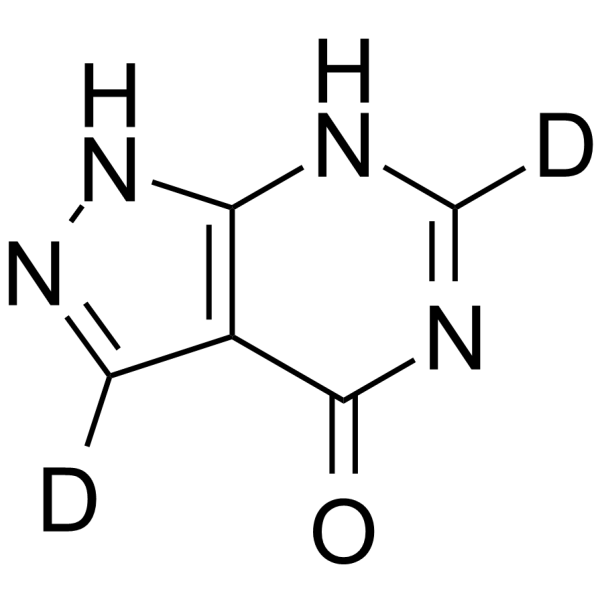Allopurinol-d2
Modify Date: 2025-08-25 15:20:10

Allopurinol-d2 structure
|
Common Name | Allopurinol-d2 | ||
|---|---|---|---|---|
| CAS Number | 916979-34-5 | Molecular Weight | 138.12 | |
| Density | 1.92g/cm3 | Boiling Point | >222°C | |
| Molecular Formula | C5H2D2N4O | Melting Point | N/A | |
| MSDS | N/A | Flash Point | 234.117°C | |
Use of Allopurinol-d2Allopurinol-d2 is deuterium labeled Allopurinol. Allopurinol is a potent xanthine oxidase inhibitor (IC50 values of 0.2 to 50 μM). Allopurinol can be used for the research of hyperuricemia and gout. Antileishmanial effect[1][2]. |
| Name | 3,6-dideuterio-1,2-dihydropyrazolo[3,4-d]pyrimidin-4-one |
|---|---|
| Synonym | More Synonyms |
| Description | Allopurinol-d2 is deuterium labeled Allopurinol. Allopurinol is a potent xanthine oxidase inhibitor (IC50 values of 0.2 to 50 μM). Allopurinol can be used for the research of hyperuricemia and gout. Antileishmanial effect[1][2]. |
|---|---|
| Related Catalog | |
| In Vitro | Stable heavy isotopes of hydrogen, carbon, and other elements have been incorporated into drug molecules, largely as tracers for quantitation during the drug development process. Deuteration has gained attention because of its potential to affect the pharmacokinetic and metabolic profiles of drugs[1]. |
| References |
| Density | 1.92g/cm3 |
|---|---|
| Boiling Point | >222°C |
| Molecular Formula | C5H2D2N4O |
| Molecular Weight | 138.12 |
| Flash Point | 234.117°C |
| Exact Mass | 138.05100 |
| PSA | 74.69000 |
| LogP | 0.05850 |
| Hazard Codes | T+ |
|---|---|
| RIDADR | 2811.0 |
| Allopurinol-d2 |
| Caplenal-d2 |
| Adenock-d2 |
| Allopur-d2 |
| Cellidrin-d2 |